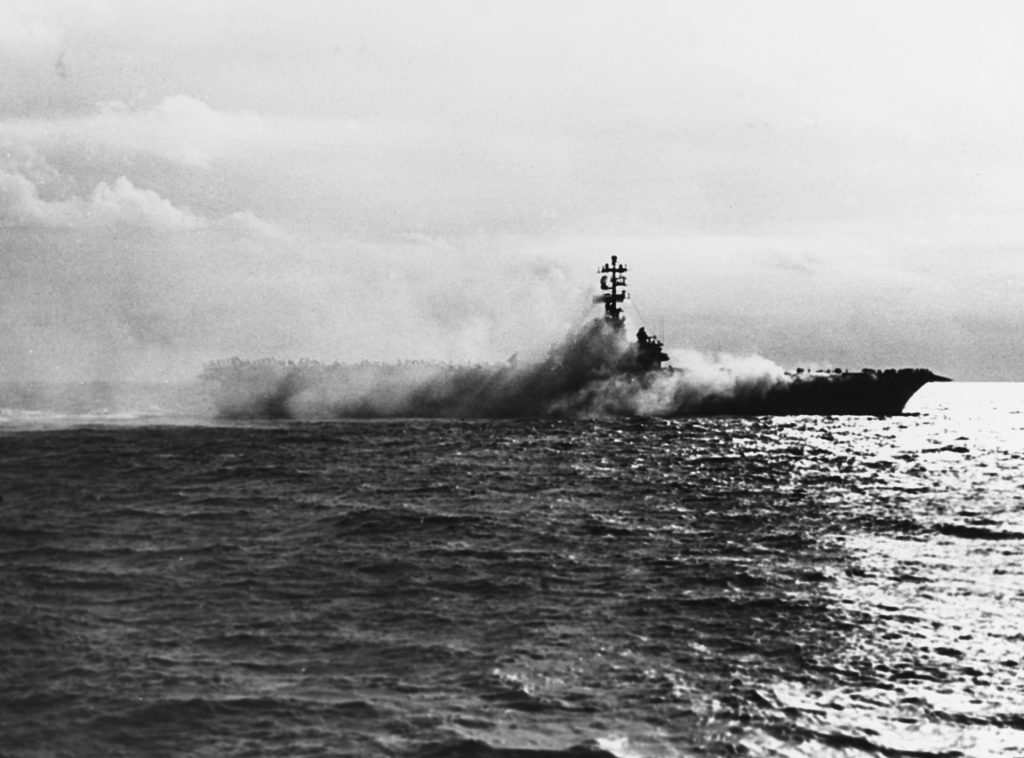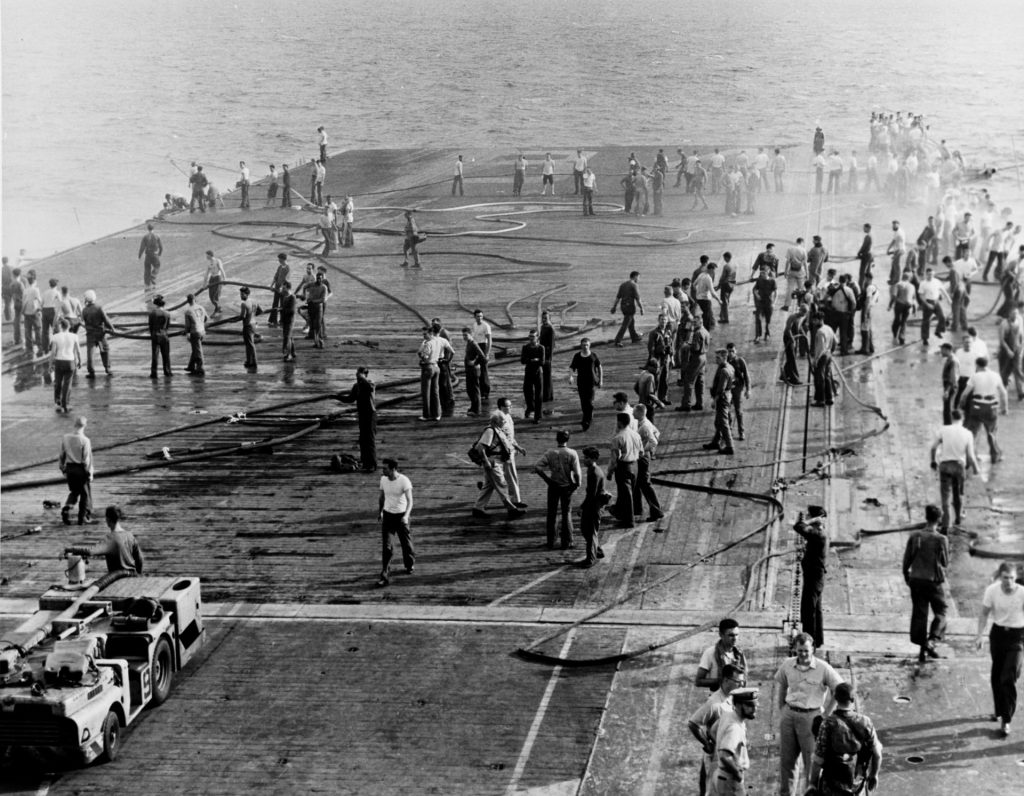In the early hours of October 26, 1966, a catastrophic fire engulfed the USS Oriskany, an Essex-class aircraft carrier stationed in the Gulf of Tonkin during the Vietnam War.

The blaze, triggered by the accidental ignition of a magnesium flare, rapidly spread through the ship, claiming the lives of 44 sailors and marking one of the deadliest naval disasters of the time.
Background Of USS Oriskany
The USS Oriskany, designated CV-34, was an Essex-class aircraft carrier, a class that played a pivotal role in the United States Navy during and after World War II.
Her keel was laid down on May 1, 1944, at the New York Naval Shipyard, but her construction was suspended at the end of the war.
It wasn’t until the outbreak of the Korean War that the construction of Oriskany was resumed, and she was finally commissioned on September 25, 1950.
The Oriskany was unique among her sister ships. Due to the suspension and resumption of her construction, she incorporated more modern design elements that were not present in the earlier Essex-class carriers.
Notably, she was completed with an angled flight deck, a revolutionary change in aircraft carrier design that allowed for safer and more efficient operations of jet aircraft.
After her commissioning, the Oriskany quickly saw action in the Korean War. She played a significant role in this conflict, primarily providing air support for ground troops and engaging in aerial combat.
Her aircraft participated in various missions, from bombing runs to reconnaissance.
The experience gained in the Korean War proved invaluable for the ship and her crew, shaping their operational tactics and understanding of carrier-based warfare.
 USS Oriskany near Midway in 1967.
USS Oriskany near Midway in 1967.
Post-Korean War, Oriskany underwent a series of upgrades and refits, which were part of a larger effort to modernize the U.S. Navy’s carrier fleet in response to the evolving demands of the Cold War.
These upgrades, under the SCB-27 and SCB-125 modernization programs, significantly enhanced her capability to host more modern, heavier jet fighters and bombers.
The enhancements included improvements to the flight deck, the installation of new steam catapults, and the strengthening of the deck structure.
These changes allowed the Oriskany to operate a new generation of naval aircraft, keeping her at the forefront of U.S. naval power projection.
By the early 1960s, the Oriskany was deployed to Southeast Asia, participating in the Vietnam War. During this period, she was involved in several major operations, including Operation Rolling Thunder.
Her air wing carried out numerous sorties against targets in North Vietnam, providing critical support to U.S. and allied ground forces.
Prelude To The Fire
In 1966, the USS Oriskany was deeply involved in the Vietnam War, particularly in Operation Rolling Thunder, a significant and intensive bombing campaign against North Vietnam.
This operation demanded a high operational tempo with frequent and rigorous flight operations.
The Oriskany’s role as an aircraft carrier meant it was launching and recovering planes almost continuously, a process that required precise coordination and placed considerable strain on both the crew and the aircraft.
Life aboard the Oriskany during this period was marked by constant vigilance and readiness. The crew had to maintain a state of high alert, given the ongoing combat operations.
This state of sustained operational pressure could lead to fatigue, a factor known to affect judgment and increase the risk of accidents.

The ship itself, like all aircraft carriers of the time, carried various hazardous materials necessary for its operations. These included aviation fuel, ordnance, and flares.
The storage and handling of these materials, especially in a combat zone, were fraught with risks. Regular safety protocols were in place for handling such materials, but the stress of combat operations might have affected their strict adherence.
A key factor in the onset of the fire was the presence of magnesium flares on board. These flares, used for illumination during night operations, were highly combustible and, if ignited, difficult to extinguish.
The handling and storage of these flares under the stressful and busy conditions of war increased the risk of an accident.
The Fire Of 1966
On the morning of October 26, 1966, a catastrophic fire broke out on the Oriskany. The blaze was initiated by the accidental ignition of a magnesium flare.
These flares, used for signaling and illumination during operations, were stored in the ship’s hangar deck. Magnesium, the material used in these flares, is known for burning at extremely high temperatures and is notoriously difficult to extinguish once ignited.
The fire rapidly spread through the hangar deck, fueled by the presence of highly flammable materials such as aviation fuel, munitions, and other combustibles.
These materials were integral to the ship’s primary function as an aircraft carrier but also posed a significant risk in the event of a fire.
The hangar deck, densely packed with aircraft and equipment, provided ample fuel for the fire, leading to a quick and uncontrollable spread.
The design of the Oriskany, like many ships of its time, featured a complex labyrinth of passageways and compartments. This layout, while efficient for normal operations, posed a significant challenge for firefighting efforts.
The thick smoke from the burning magnesium and aviation fuel severely limited visibility and made navigation through the ship’s corridors extremely hazardous.
 Smoke clouds rise from the Oriskany while crews battle the blaze.
Smoke clouds rise from the Oriskany while crews battle the blaze.
Furthermore, the ship’s firefighting equipment, although state-of-the-art for its time, was not designed to handle a fire of this magnitude and complexity. The intense heat generated by the magnesium flare compromised the effectiveness of the firefighting measures in place.
Despite these daunting challenges, the crew of the Oriskany responded with remarkable bravery and determination.
Crew members risked their lives fighting the fire, attempting to rescue trapped shipmates, and working to prevent the blaze from reaching the ship’s magazines, where large quantities of explosives were stored. Their efforts were critical in preventing an even greater catastrophe.
Despite the heroic efforts of the crew, the fire claimed the lives of 44 sailors. This tragic loss of life made it one of the deadliest fires aboard a U.S. warship since World War II. Many more were injured, some severely, adding to the tragedy of the event.
Aftermath
Following the tragic fire, the USS Oriskany was immediately docked at the U.S. Naval Base in Subic Bay, Philippines, for emergency repairs.
These repairs were crucial to ensure the ship’s seaworthiness for its journey back to the United States. Once in the U.S., the Oriskany underwent an extensive overhaul at the San Francisco Naval Shipyard.
This comprehensive process not only repaired the damage caused by the fire but also included updates to various systems and structural improvements, informed by the lessons learned from the fire.
After the completion of the repairs and refurbishments, the Oriskany was recommissioned and rejoined the U.S. Navy’s Pacific Fleet.
Despite the setback of the fire, the carrier resumed its active role, particularly in the Vietnam War. The Oriskany returned to the Gulf of Tonkin, where its air wing continued to engage in combat operations.
 The forward flight deck of the Oriskany as the crews fight to put the fire out.
The forward flight deck of the Oriskany as the crews fight to put the fire out.
The Oriskany continued to serve in the U.S. Navy for several years following its return to service.
The carrier participated in various exercises and operations in the Pacific, maintaining its status as a vital component of the U.S. naval force.
However, as newer and more advanced carriers were commissioned, the Oriskany’s role diminished, leading to its eventual decommissioning in 1976.
This marked the end of over two decades of distinguished service.
In a unique and environmentally conscious decision, the USS Oriskany was repurposed as an artificial reef in 2006.
Prior to being sunk in the Gulf of Mexico, the ship underwent thorough environmental preparation to remove any hazardous materials.
The sinking of the Oriskany was a carefully planned and executed operation, turning the decommissioned carrier into one of the largest artificial reefs globally.
This has since become a popular site for recreational diving, offering a new form of marine life habitat and a unique underwater experience.





